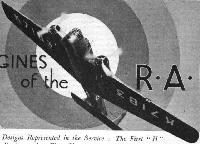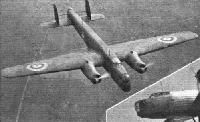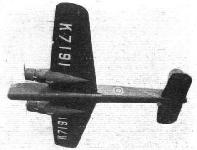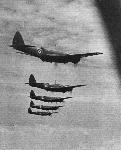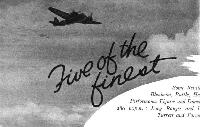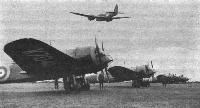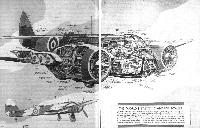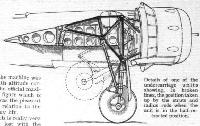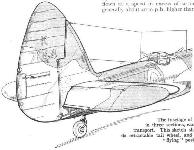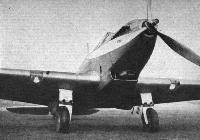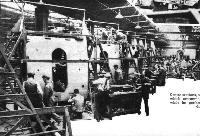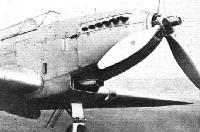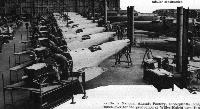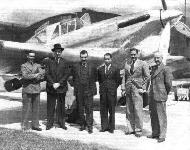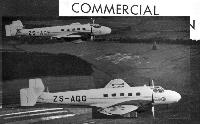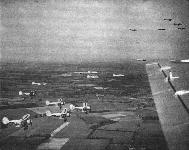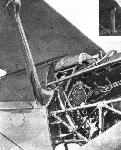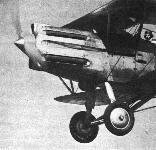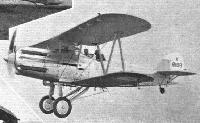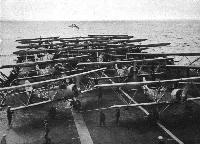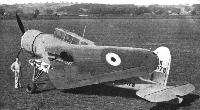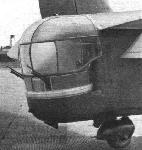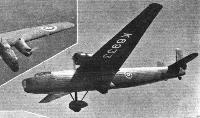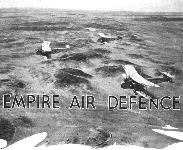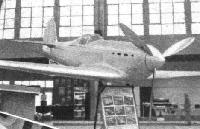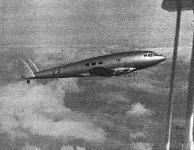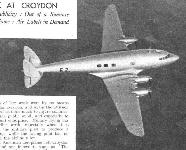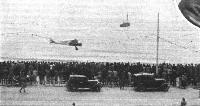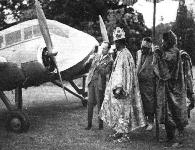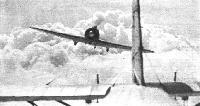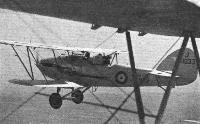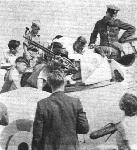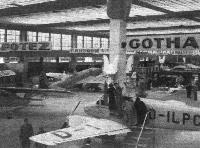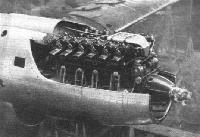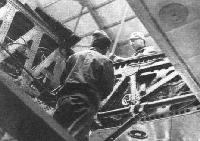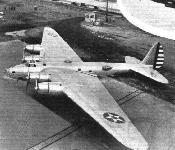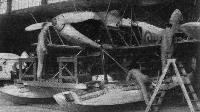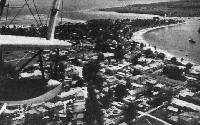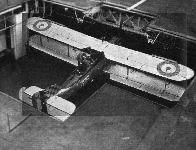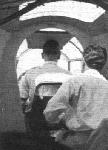Фотографии
-
Регистрационный номер: K7183 Самолёты на фотографии: Armstrong Whitworth Whitley / A.W.38 - Великобритания - 1936
-
The Armstrong Whitworth Whitley is a heavy bomber with two Siddeley Tiger engines, which, in later models, have two-speed superchargers
Самолёты на фотографии: Armstrong Whitworth Whitley / A.W.38 - Великобритания - 1936
-
Регистрационный номер: K7191 Самолёты на фотографии: Armstrong Whitworth Whitley / A.W.38 - Великобритания - 1936
-
Регистрационный номер: K7189 View of the Armstrong Whitworth Whitley which show its general proportions and the gun turrets in the nose.
Самолёты на фотографии: Armstrong Whitworth Whitley / A.W.38 - Великобритания - 1936
-
Самолёты на фотографии: Bristol Blenheim - Великобритания - 1936
-
A flight of Bristol Blenheims, 280 m.p.h. bombers
Самолёты на фотографии: Bristol Blenheim - Великобритания - 1936
-
THE LADDER OF FAME: Bristol Blenheim medium bombers of No. 114 (B.) Squadron at Wyton. The degree of accuracy attained by this unit after only a few weeks' practice is apparent in this view of an echelon formation. The Blenheims are probably the fastest machines in service anywhere in the world.
Самолёты на фотографии: Bristol Blenheim - Великобритания - 1936
-
Самолёты на фотографии: Bristol Blenheim - Великобритания - 1936
-
Регистрационный номер: K7046 [2] A slow-flying demonstration by a Blenheim at Wyton.
Самолёты на фотографии: Bristol Blenheim - Великобритания - 1936
-
Регистрационный номер: K7046 [2] Machines of our first Blenheim unit - No. 114 (B) Squadron at Wyton. These aircraft are by far the fastest bombers in service anywhere in the world.
Самолёты на фотографии: Bristol Blenheim - Великобритания - 1936
-
A plan view of the Blenheim's control cabin, showing the tidy instrument panel and giving some idea of the range of view provided for the pilot and bomber-navigator. On the right of the pilot's seat can be seen one of the two trimming wheels and the three hydraulic control plungers in line behind it; the trimming indicators are on the right side of the dash, while those for the undercarriage and flaps are on the left side of the cabin.
Самолёты на фотографии: Bristol Blenheim - Великобритания - 1936
-
Самолёты на фотографии: Bristol Blenheim - Великобритания - 1936
-
Details of one of the undercarriage units showing, in broken lines, the position taken up by the struts and radius rods when the unit is in the half-retracted position.
Самолёты на фотографии: Bristol Blenheim - Великобритания - 1936
-
The fuselage of the Blenheim is made in three sections, each of a size suitable for transport. This sketch shows the tail unit with its retractable tail wheel, and the rear turret in its "flying" position.
Самолёты на фотографии: Bristol Blenheim - Великобритания - 1936
-
"Massive strength and rakish speed" (according to the picture agency's caption) are displayed by these A.N.T.6 bombers.
Самолёты на фотографии: Туполев ТБ-3 / АНТ-6 - Россия - 1930
-
The main erecting shop at the Stockport works. Note the "crash pylons" on the forward portion of the monocoque structures.
Самолёты на фотографии: Fairey Battle - Великобритания - 1936
-
An uncowled Rolls-Royce Merlin engine in a production Fairey Battle reveals the down-facing carburettor in-take with its scoop, the separate radiators and details of mounting.
Самолёты на фотографии: Fairey Battle - Великобритания - 1936
-
Tho location of such items as radiator, undercarriage and landing lights are shown in this view of the nose of a Battle. The clean installation of the 990/1,050 h.p. Merlin is noteworthy.
Самолёты на фотографии: Fairey Battle - Великобритания - 1936
-
The outer panels of Battle wings are seen here taking shape. Note, near the roots, provision for the undercarriage and bomb storage.
Самолёты на фотографии: Fairey Battle - Великобритания - 1936
-
Centre sections, showing the "well" which accommodates the observer while he performs certain of his duties.
Самолёты на фотографии: Fairey Battle - Великобритания - 1936
-
The finished product faired and cowled. The latest type of exhaust manifold, shown in the first illustration, may be compared with the more familiar stubs seen below.
Самолёты на фотографии: Fairey Battle - Великобритания - 1936
-
Grimly businesslike in its dark camouflage - the Fairey Battle, which is now being supplied to the Belgian Air Force.
Самолёты на фотографии: Fairey Battle - Великобритания - 1936
-
Assembling the monocoque portions of Battle fuselages in the Stockport works. The size of the rear cockpit may be gathered from the fuselage in the foreground.
Самолёты на фотографии: Fairey Battle - Великобритания - 1936
-
The completed Battle fuselages in this view have received their Merlins. It will be seen that the first two bays are of tubular construction.
Самолёты на фотографии: Fairey Battle - Великобритания - 1936
-
Регистрационный номер: K4303 [2] Самолёты на фотографии: Fairey Battle - Великобритания - 1936
-
Регистрационный номер: K4303 [2] The Fairey Battle is the latest single-engined bomber to go into service. Its engine is the glycol-cooled R.-R. Merlin I, which gives it a top speed of 257 m.p.h.
Самолёты на фотографии: Fairey Battle - Великобритания - 1936
-
An interesting comparison of open and closed cooling gills on the Westland Lysander with Bristol Mercury VIII engine is seen in these two photographs, taken immediately prior to take-off and just after take-off.
Самолёты на фотографии: Westland Lysander - Великобритания - 1936
-
Регистрационный номер: L5912 MILITARY MILES: A Miles Magister trainer (130 h.p. D.H. Gipsy Major) as delivered to the R.A.F. The Magister is a development of the Hawk Major series and is fitted with a new pattern of undercarriage. It incorporates, of course, Miles split flaps.
Самолёты на фотографии: Miles Magister / M.14 - Великобритания - 1937
-
Under the shining "bonnet" of the Miles Magister is a De Havilland Gipsy Major engine.
Самолёты на фотографии: Miles Magister / M.14 - Великобритания - 1937
-
AT THE BRUSSELS SHOW: A new German two-seater military trainer, the Arado Ar.96. It provides for instruction in flying, radio, gunnery, photography and bombing. The engine is a 240 h.p. inverted vee-eight Argus.
Самолёты на фотографии: Arado Ar.96 - Германия - 1938
-
The De Havilland Don advanced trainer, ordered in quantity for the R.A.F., is fitted with the D.H. Gipsyking inverted vee-twelve engine, better known as the Gipsy Twelve.
Самолёты на фотографии: De Havilland Don / D.H.93 - Великобритания - 1937
-
AMBASSADORIAL APPROVAL: Last week, H. E. Alfifi Pasha, the Egyptian Ambassador, visited Brooklands to see the Hawker P.4 and the Miles Magister, the latter having been brought over from Reading. In this group, left to right, are Flt. Lt. P. G. Lucas, Capt. Tait Bey, H. E. Alfifi Pasha, Capt. Nagi, Capt. Razik and Flt. Lt. P. W. S. Bulman. The Hawker P.4 is behind.
Самолёты на фотографии: Hawker Henley - Великобритания - 1937
-
On this spatted Mark II Fury, with 600 h.p. Kestrel engine, can be seen the almost flush exhaust stubs and the swelled strut indicating composite cooling.
Самолёты на фотографии: Hawker Fury - Великобритания - 1931
-
Регистрационный номер: K7718 Capable of flying for very long distances at a high cruising speed, the Vickers Wellesley has been adopted for general purpose and bombing duties.
Самолёты на фотографии: Vickers Wellesley - Великобритания - 1935
-
Регистрационный номер: ZS-AGF, ZS-AGG CIVIL KESTRELS: These two South African Airways' Junkers Ju.86s, seen flying near Dessau, are fitted with fully supercharged Kestrel XVIs, and should by now have reached Johannesburg on their delivery flight
ZS-AGG - one of the original Ju 86s for South African Airways, with Rolls-Royce Kestrel engines. Before delivery, Pratt & Whitney Hornet engines were substituted, bringing the aircraft up to Ju 86Z-7 standard.Самолёты на фотографии: Junkers Ju.86 - Германия - 1934
-
Gloster Gauntlet fighters in squadron formation.
Самолёты на фотографии: Gloster Gauntlet - Великобритания - 1929
-
SKY PARADE: Gauntlets, Ansons and Harrows in a "skeleton flight" rehearsal for the massed fly-past which will feature in the RA.F. Display to be held at Hendon on June 26. It is to be hoped that the squadrons will fly at closer intervals and at a lower altitude than did those in the so-called fly-past of two years ago.
Самолёты на фотографии: Avro Anson / Type 652 - Великобритания - 1935Gloster Gauntlet - Великобритания - 1929Handley Page Harrow / H.P.54 - Великобритания - 1936
-
In the large photograph details of composite cooling system, including the pipe leading to the specially faired strut, can be seen. The machine in the latter case is a Hawker Hind
Самолёты на фотографии: Hawker Hind - Великобритания - 1934
-
In this handsome photograph of a Hector's nose, the countersunk exhaust manifolds, streamlined air cooling and air intake scoops, and oil radiator are characteristic features.
Самолёты на фотографии: Hawker Hector - Великобритания - 1936
-
The first Daggers in the Service: 200 m.p.h. Hawker Hectors of No. 13 (A.C.) Squadron, which are fitted with Dagger III engines.
Самолёты на фотографии: Hawker Hector - Великобритания - 1936
-
Hectors of No. 13 (A.C.) Squadron, Odiham, practising an echelon formation above the clouds.
Самолёты на фотографии: Hawker Hector - Великобритания - 1936
-
Регистрационный номер: K8108 [2] Sqn. Ldr.. S. H. C. Gray, O.C. No. 13 (A.C.) Squadron, in his Dagger-engined Hector. This view shows the countersunk exhausts, which act as admirable flame-dampers.
Самолёты на фотографии: Hawker Hector - Великобритания - 1936
-
Регистрационный номер: K8108 [2] The Hawker Hector, the latest army co-operation type to go into service
Самолёты на фотографии: Hawker Hector - Великобритания - 1936
-
Регистрационный номер: K4109 R.A.F. MOBILITY: The Vincents of No. 84 (Bomber) Squadron from Shaibah, near Basra, receiving fuel and routine attention when on an inter-command flight across India.
Самолёты на фотографии: Vickers Vincent / Type 266 - Великобритания - 1932
-
"The aircraft to be flown-off are brought up on the lifts from the hangars below decks and are ranged up behind each other on the flight deck. Often two or more squadrons are so ranged up at the same time." Sharks and Baffins are seen in this striking photograph taken on board H.M.S. Courageous.
Самолёты на фотографии: Blackburn Baffin / B-5 - Великобритания - 1933Blackburn Shark / B-6 - Великобритания - 1933
-
Регистрационный номер: K6291, K6295, K6296 Avro Ansons are the aircraft of the general reconnaissance squadrons which patrol the waters round the coast of Britain.
Самолёты на фотографии: Avro Anson / Type 652 - Великобритания - 1935
-
One of the seven-cylinder Armstrong Siddeley Cheetah IXs installed in an Avro Anson.
Самолёты на фотографии: Avro Anson / Type 652 - Великобритания - 1935
-
Регистрационный номер: K5178 In a machine such as the new Blackburn fleet-fighter dive-bomber, seen here with one wing folded, high performance must not entail the sacrifice of load-carrying ability or practical folding and handling arrangements.
Самолёты на фотографии: Blackburn Skua / B-24 - Великобритания - 1937
-
Регистрационный номер: K5099 Built to the same specification - P.4/34 - the Fairey Merlin-engined light bomber are undoubtedly the fastest machine of its calibre in the world.
Самолёты на фотографии: Fairey Fulmar / P.4/34 - Великобритания - 1937
-
Typical aerodrome scene indicative of the colourful spectacles to be seen all over the country on Saturday, here, with a Harrow in prominence, at Biggin Hill.
Самолёты на фотографии: Handley Page Harrow / H.P.54 - Великобритания - 1936
-
The Flight photograph shows the stern defence (conceived by the Nash and Thompson) of a Harrow.
Самолёты на фотографии: Handley Page Harrow / H.P.54 - Великобритания - 1936
-
Регистрационный номер: K6933 The Handley Page Harrow is in the same category as A.W. Whitley and mounts a pair of Bristol Pegasus engines.
Самолёты на фотографии: Handley Page Harrow / H.P.54 - Великобритания - 1936
-
Deserts are quite a usual feature of overseas air work. Here Vickers Valentia transports are seen carrying supplies from Egypt to Palestine.
Самолёты на фотографии: Vickers Valentia - Великобритания - 1934
-
The most striking fighter in the Show - the Renard R.36.
Самолёты на фотографии: Renard R.36 / R.37 - Бельгия - 1937
-
TRANSCENDENT TRANSPORT: Perfection of line and an unsullied exterior combine to convey the impression that this is not an actual photograph but a spurious representation of the Albatross in flight, achieved with the aid of a model. In actual fact, this revealing picture of De Havillands' masterpiece was secured by Flight's photographer near Hatfield last week during a test flight by Mr. Waight.
Самолёты на фотографии: De Havilland Albatross / D.H.91 - Великобритания - 1937
-
EARMARKED: Anyone who had been out of touch with aeronautical developments might easily recognise the Albatross as a De Havilland product. Although more-or-less orthodox in lay-out this ninety-first De Havilland design features many structural innovations and very advanced power plant installations.
Самолёты на фотографии: De Havilland Albatross / D.H.91 - Великобритания - 1937
-
In the Bendix fluid-operated brake, as fitted to the D.H. Albatross, the piston in the operating cylinder forces apart two tappets which bear on the shoes.
Самолёты на фотографии: De Havilland Albatross / D.H.91 - Великобритания - 1937
-
One of the most impressive transport aeroplanes ever built, the De Havilland Albatross is estimated to cruise at about 200 m.p.h. Its four engines are Gipsy Twelves.
Самолёты на фотографии: De Havilland Albatross / D.H.91 - Великобритания - 1937
-
Some idea of the conditions prevailing at Douglas on Saturday can be gathered from this photograph of the first machine home - Mr. J. A. M. Henderson's Monospar - crossing the line at zero altitude.
Самолёты на фотографии: General Aircraft Monospar ST-25 Universal - Великобритания - 1935
-
HANWORTH HOSPITALITY: During the visit last week of Ademola II, Alake of Abeokuta, Nigeria, to the London Air Park Lord Sempill explained various points of the latest Monospar and flew the Alake round for about half an hour.
Самолёты на фотографии: General Aircraft Monospar ST-25 Universal - Великобритания - 1935
-
Регистрационный номер: K5604 [3] FLEDGED: The eagerly awaited Gloster multi-gun monoplane fighter, which, judging by appearances, should occupy an extremely small period of time in getting from x to y at the behest of the Mercury or the sleeve-valve Perseus, which are its alternative power plants. Note the forward position of the fin and rudder relative to the tail plane.
Самолёты на фотографии: Gloster F.5/34 - Великобритания - 1937
-
Регистрационный номер: K5604 [3] The new Gloster multi-gun fighter monoplane fitted, at the moment, with a Bristol Mercury engine.
Самолёты на фотографии: Gloster F.5/34 - Великобритания - 1937
-
BACKGROUND: The latest of a long and brilliant line of Gloster fighters, the new multi-gun monoplane is designed to take a Bristol radial. A Mercury is installed in the prototype, seen here looking in on Hawker's "-MR," but a sleeve-valve Perseus may later be substituted.
Самолёты на фотографии: Gloster F.5/34 - Великобритания - 1937
-
Регистрационный номер: K5604 [3] GLOSTER'S LATEST: A three-quarter-front aspect of the new monoplane fighter. Leading dimensions are: Span, 38ft. 2in.; length, 31ft. 1in.; height, 10ft. 1in.
Самолёты на фотографии: Gloster F.5/34 - Великобритания - 1937
-
Регистрационный номер: K4511, K4515, K4520 Dramatic "shot" of Demons of No. 64 (F.) Squadron, a tight echelon
Самолёты на фотографии: Hawker Demon - Великобритания - 1932
-
Регистрационный номер: J9933 A CRUSTACEAN DEMON: The Nash and Thompson turret on a Hawker Demon. The shield portion is reminiscent of a lobster's tail and in this view is seen folded down, being linked with the elevating mechanism.
Самолёты на фотографии: Hawker Demon - Великобритания - 1932
-
TOTS AND TURRETS: Some of the younger element at Saturday's Northolt display assess the merits of a Nash and Thompson turret of the Turret Demon.
Самолёты на фотографии: Hawker Demon - Великобритания - 1932
-
Регистрационный номер: D-IOSA The eventual winner of the main race and runner-up in the Manx Air Derby, Major Seidemann, opens up his Messerschmitt for the take-off at Hanworth. In the background is the second B.F.W., which was piloted by Herr Gerbrecht.
Самолёты на фотографии: Messerschmitt Bf.108 Taifun - Германия - 1934
-
Finale: Herr Wendel (inset) winds up his demonstration with the Bucker Jungmeister with a high-speed inverted passage across the aerodrome at zero altitude. When this picture was taken he was climbing to avoid the Short Scion on the left; on his previous passage the Bucker's tail fin positively stroked the grass - to the terrified joy of the onlookers.
Самолёты на фотографии: Bucker Bu.133 Jungmeister - Германия - 1935Short Scion / S.16 - Великобритания - 1933
-
The Final of the handicap race: the winning Klemm 35 (Tolxis) and the Focke Wulf 44 (von Braun) turning away from each other after they had crossed the line.
Самолёты на фотографии: Focke-Wulf FW.44 Steiglitz - Германия - 1932Klemm Kl.35 / Kl.106 - Германия - 1935
-
Регистрационный номер: D-ILPC A general view of part of the Show with the new Gotha Go. 146 in the foreground. In the distance, on the French stand, is the military version of the Caudron Typhon.
Самолёты на фотографии: Caudron C.640 Typhoon - Франция - 1935Gotha Go.146 - Германия - 1935
-
Herr Hellman Tolxis and Herr Ritsch, his passenger, who came over in a Klemm 35, are linguistically assisted by the ever-helpful Mr. R. L'E. Malone of Airwork.
Самолёты на фотографии: Klemm Kl.35 / Kl.106 - Германия - 1935
-
The view shows the installation of vee-twelve engine in the new Japanese long-range monoplane.
Самолёты на фотографии: Tokyo Gasu Denki Koken - Япония - 1937
-
The view reveals the substantial mounting.
Самолёты на фотографии: Tokyo Gasu Denki Koken - Япония - 1937
-
The high aspect ratio of the new monoplane's wing and the lines of the fuselage are apparent here
Самолёты на фотографии: Tokyo Gasu Denki Koken - Япония - 1937
-
The experimental XB-15 Boeing (four Twin-Wasps), which is even larger, but which, according to the latest information, has not been flown.
Самолёты на фотографии: Boeing B-15 - США - 1937
-
Самолёты на фотографии: Boeing B-15 - США - 1937
-
Marconi installation in a British Airways Lockheed Electra. On the forward bulkhead is the receiver-transmitter unit, and in the cockpit roof is the D/F loop indicator which has a repeater on the panel in the foreground.
Самолёты на фотографии: Lockheed Electra 10 - США - 1934
-
Регистрационный номер: G-ADJO The two Eagles (Flt. Lt. Rose and Mr. H. J. Wilson up) get away from Ronaldsway on the Manx race. Though they have hardly crossed the boundary - and have not started to put on bank for the turn on to course - the undercarriages are up.
Самолёты на фотографии: British Klemm BK-1 Eagle - Великобритания - 1934
-
Fitters and riggers at work on a Hawker Osprey.
Самолёты на фотографии: Hawker Osprey - Великобритания - 1930
-
SPERRY PILOT NUMBER ONE: This 1915 Curtiss boat was equipped with a Sperry "Stabiliser" which can be seen in the nose at the bottom of the picture. The "Stabiliser" was the real ancestor of the automatic pilot as we know it to-day.
Самолёты на фотографии: Curtiss F - США - 1913
-
"Landing-on is a far more difficult process ... everything should be done to make it as easy as possible" Blackburn Bafhns coming in.
Самолёты на фотографии: Blackburn Baffin / B-5 - Великобритания - 1933
-
Under the Calcutta's float, in the photograph is the town of Dar-es-Salaam, with the harbour mouth on the right.
Самолёты на фотографии: Short Calcutta / Rangoon / S.8 - Великобритания - 1928
-
The well-planned and seemingly spacious town of Lourenco Marquez - the last base before Durban, where S.A.A. take over the good work.
Самолёты на фотографии: Short Calcutta / Rangoon / S.8 - Великобритания - 1928
-
Регистрационный номер: K2911 "Entry into the arrester gear at too high a speed throws a great strain on both the aircraft and the deck cables." This remark of the author's can be readily appreciated by a study of this photograph, which shows a Hawker Nimrod being checked by an arrester cable on the deck of an aircraft carrier.
Самолёты на фотографии: Hawker Nimrod - Великобритания - 1931
-
Регистрационный номер: S1189 The illustration shows a Fairey III.F in the hold of the aircraft carrier H.M.S. "Courageous." As an indication of their wide adoption for Fleet Air Arm operation, 12 units out of a total of 18 of this branch of the Royal Air Force are equipped with Fairey aircraft.
Самолёты на фотографии: Fairey Fairey IIIF - Великобритания - 1926
-
The impressive machines in the photograph are three of the thirteen Boeing YB-17 bombers, each fitted with four 1,000 h.p. Wright "Cyclone" engines, ordered by the U.S. Army Air Corps.
Самолёты на фотографии: Boeing B-17 Flying Fortress - США - 1935
-
Supermarine Scapa flying boats in the Firth of Forth.
Самолёты на фотографии: Supermarine Scapa - Великобритания - 1932
-
Flt. Lt. J. B. Wilson (at the controls) and Mr. D. M. Bey (navigator) photographed in the B.A. Double Eagle as it crossed the Chilterns at 2,000ft. on the way to Speke.
Самолёты на фотографии: British Aircraft BA.IV Double Eagle - Великобритания - 1936
-
Регистрационный номер: G-AEMA STRESSED SHIN IN MINIATURE. Capt. Hubert Broad flies the new C.W. Cygnet for the benefit of "Flight's" photographer. As will be seen there is a certain amount of cleaning up still to be done, but with a Cirrus Minor engine the Cygnet has a cruising speed of well over 100 m.p.h. and an 800-ft.-a-minute climb.
Самолёты на фотографии: C.W. Aircraft Cygnet - Великобритания - 1937
-
Among the new private-owner types was this attractive little side-by-side two-seater Oplinter monoplane, with Cirrus Minor engine.
Самолёты на фотографии: Wouters (Oplinter) W.4 - Бельгия - 1937
Статьи
- Flight
- Flight Advertisements
